|
Home | Blog Index | Blog Archives | Christianity & Faith Essays | Storm Chasing Essays
The case for stacking lightning photos
|
In September of 2025, my work is generating the most income it ever has in my career. Yet, I'm being forced to shut down my successul operation, against my will, due to one cause alone: 95% of that revenue is being stolen by piracy and copyright infringement. I've lost more than $1 million to copyright infringement in the last 15 years, and it's finally brought an end to my professional storm chasing operation. Do not be misled by the lies of infringers, anti-copyright activists and organized piracy cartels. This page is a detailed, evidenced account of my battle I had to undertake to just barely stay in business, and eventually could not overcome. It's a problem faced by all of my colleagues and most other creators in the field. |
The question comes up occasionally on whether or not it is appropriate to "stack" images. For those unfamiliar with the term, stacking means taking multiple exposures of a scene (without moving the camera) and overlaying those exposures into a single composite image using computer software. The most common subjects where stacking yields good results are with lightning strikes, star trails and meteors. For example, if a scene with a storm is framed up and multiple photos of lightning are captured while the camera remains in the same position, the resulting photos can be 'stacked' so that all of the lightning strikes are shown in the final image.
To illustrate this, here are 8 images from a storm over St. Louis I shot in September of 2010. All of this lightning happened in a 20 minute timespan, and the camera did not move during the storm.
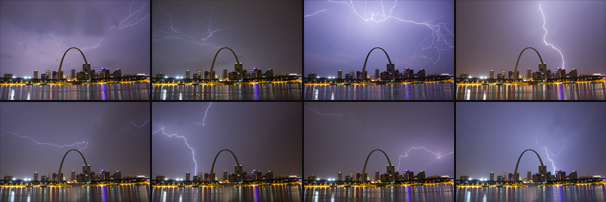
Using editing software, I merged or "stacked" those 8 images into a single photo. This is the result:
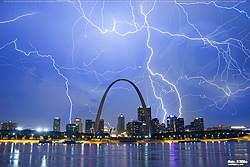
Here are a few other examples of my lightning images where I employed the stacking technique (click any to view a larger version):
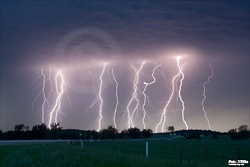 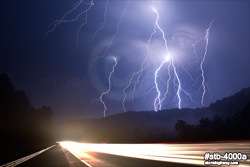
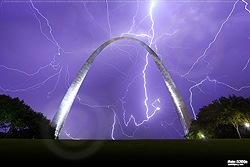
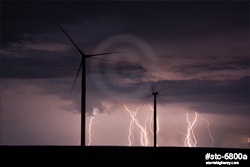
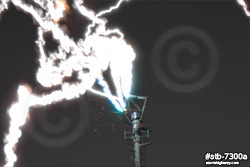
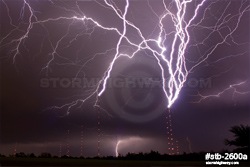
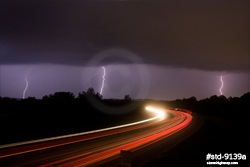
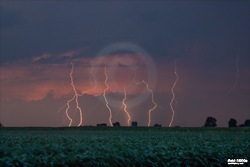
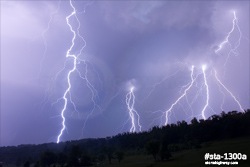
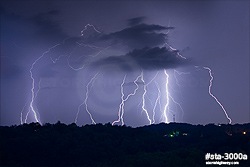
As far as lightning is concerned, stacking multiple exposures yields identical results to that of a single long exposure, a technique that has been used throughout the history of photography. For instance, if you were out in the Arizona desert with no city lights in view, you could do a single 20-minute exposure of a storm and capture 50 bolts of lightning on that one exposure. Alternatively, you could do forty 30-second exposures (each with one or two lightning bolts in them), or 20 one-minute exposures, then digitally "stack" them all into one image. In the end, both of those techniques will yield exactly the same result: a single photo showing 50 lightning strikes.
Nighttime scenes with ambient light sources, IE, city skylines or urban areas, are situations where extremely long exposure times are not possible, because they would result in catastrophically overexposed images. For example, a typical nighttime exposure of a city skyline at 100ASA is around 10 seconds at an F8 aperture. If you go longer than that, the buildings, light sources and sky will begin to wash out and overexpose. Exposing a city scene for several minutes, even at night, would make the image completely white, or close to it! Therefore, shooting lightning in a city requires doing numerous short exposures, capturing one or two lightning bolts in each photo. Today's digital imaging technology allows those images to be "stacked" together into one image, just as if you had been able to do a single exposure many minutes in length.
In my opinion, stacking is the digital equivalent of a long film exposure, with the technology allowing the "limiting" of the exposure of ambient light sources in the final image. Back in my film days, I shot numerous photos of storms with long exposure times (several minutes long), resulting in many lightning bolts in a single image. Here are a couple of examples. I shot this in Pennsylvania during my first season of storm chasing in 1993 on a single negative film frame, the exposure time was probably in the 6 or 7 minute range:
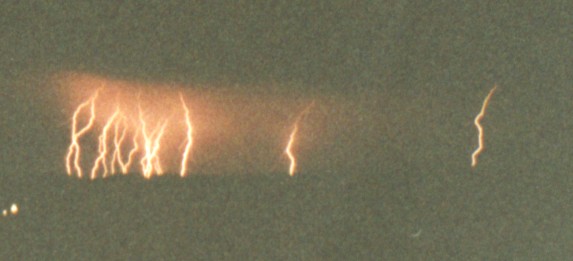
This slide film image from Texas in 2002 was captured with an exposure time of around 10 minutes in length:
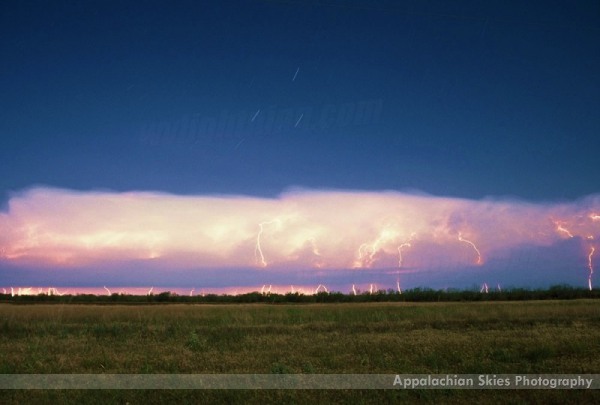
There has never been a question in photography realms as to whether this type of image (long film exposures of numerous lightning strikes) is "legitimate" or not. Images like these have always been published around the world without criticism or objection. The viewer looking at those film images is not going to assume that all of those lightning strikes happened at the same time. "Stacking" simply allows the same type of long exposure to be performed in areas with ambient light, without overexposing those ambient light sources. Nothing is fabricated or misrepresented in the image any more than those old long film exposures did. All of the lightning strikes really happened as they are shown, just not all at the same time - exactly the same case as a long film exposure in a dark landscape.
Even so, to preserve a high standard of integrity, I always disclose the fact that stacking was done to an image. So far, my lightning stacks have seen more response and appreciation from viewers (despite it being made clear they were stacks) than most of my other photos. I also include the non-stacked images alongside the stacked ones in my gallery catalog, so if a viewer/buyer prefers non-stacked images, they are there for the choosing.
One day, cameras may be able to limit ambient light "on the fly" during very long exposures, allowing the capture of an entire storm over a city in a single exposure. Until then, stacking is a very effective - and legitimate, in my opinion - way to produce long exposures containing ambient light sources, and I will continue to do them whenever the opportunity arises.
Very nice photos Dan! I need to try this. Is there a program for stacking that isn't really expensive?
I have elements9 and don't think it has this tool.
- Posted by Michael Thompson from MN | | |
Thanks Michael! I'm not sure about Elements as I've never used it. Check to see if it does 'Smart Objects' - if so, then it might be possible. There might also be some standalone software like Photomatix that does it, but since I've always had Photoshop, I've never had occasion to research other options.
- Posted by Dan R. from New Baden, IL | | |
If an audience enjoys and appreciates the creativity that goes into filling a picture with a lengthy block of time so as to tell a story then who cares what is appropriate? Be it one photo or one hundred photos, it's all still photography.
- Posted by P from IL | | |
Yeah, I see the point of the 'purists' to some degree, but at the end of the day, the stacked shots have been my most popular and therefore the best sellers. I don't make much off of stills, but some of these stacks have helped me acquire a couple of new lenses this year. I doubt I would have received donations/print sales from the purists had I chosen not to do stacking! I'm sure many of the other storm chasers who have had successful stacks would say the same thing.
- Posted by Dan R. from New Baden, IL | | |
what software did you use to stack them
- Posted by steve | | |
Lightning strikes have always been interesting to me. It's breathtaking in my opinion.
- Posted by Marla | | |
|